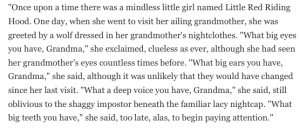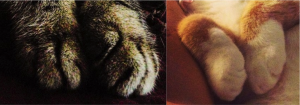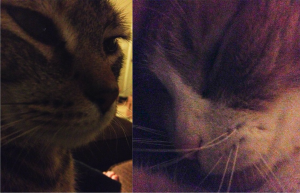In the rhythm of academia, right as we began this semester, we also selected our courses for next year. I decided to revisit my course on monsters. Soon after, a friend gave me a book of original Grimm’s fairy tales–a gruesome treasure! I didn’t expect to stumble onto mindfulness while reading through it, but I seem to find it in unexpected places almost daily.
A certain addition to the monsters course will be the story and history of what we now call “Little Red Riding Hood.” First told in the rural French countryside when the belief in werewolves was “a masculine counterpart to the witch hysteria” of the 15th through 17th centuries, it was written down and published in 1697 by Charles Perrault and then revised by the Grimm brothers just over a century later (Windling, 2004).
Before my friend gave me this book, I most recently encountered the story in Ellen J. Langer’s The Power of Mindful Learning (1997). No, really! The book’s introduction begins with a brief version of the story. (Click the image to the left.) Langer revisits the familiar fairy tale to show us that the consequences of mindlessness are already well woven into our stories, our unconscious, our culture: “Certain myths and fairy tales help advance a culture by passing on a profound and complex wisdom to succeeding generations” (p. 1).
The monsters course is one of my favorites, largely because it urges us to ask some important societal questions, including (according to my course description)
“Why do we seek out the monstrous and horrifying? What do our monsters reveal about us? What’s the relationship between our monsters and our times? How (and why) do we pass on stories of things that terrify us?”
Framed this way, mindlessness becomes deadly, and we’re devoured because we fail to recognize what’s in our immediate presence. The wolf is our mistaken priorities, our distractions, or our busyness. “What big rewards this 60-hour-a-week job gives me!”
In the years before I began a mindful practice, I mistook many wolves for grandmothers. Now, I work on keeping my eyes clear enough to notice the fur.
Practice
When I started to write this post, I was flanked by my cats, Grendel and Jack, pictured right. I was thinking about seeing what’s right in front of me with new and clear eyes. This brought me to contemplative photography, which would make a lovely practice this week. As you walk to your office, your classroom, your car, look beyond the objects you see and instead see color or texture. Andy Karr, author of The Practice of Contemplative Photography: Seeing the World with Fresh Eyes (2011a), describes it as
 a method for seeing and photographing the world in fresh ways, to reveal richness and beauty that is normally hidden from view. Instead of emphasizing subject matter or the technical aspects of photography, the contemplative approach teaches you to see clearly, and make images based on fresh perceptions. (Karr, 2011b)
a method for seeing and photographing the world in fresh ways, to reveal richness and beauty that is normally hidden from view. Instead of emphasizing subject matter or the technical aspects of photography, the contemplative approach teaches you to see clearly, and make images based on fresh perceptions. (Karr, 2011b)
His instructions are simply “pretend that your eyes have fingertips” (2013, p. 341). So live your day as you live your days, but notice colors in a new way, and let your eyes feel the textures. Snap a photo or two, and see what you notice through the photographs.
I’d love to see some examples!
—
References
Karr, Andy. (2011b). The Practice of Contemplative Photography: Seeing the World with Fresh Eyes. Boston: Shambhala.
—. (2011a). Seeing Fresh: The Practice of Contemplative Photography
—. (2013). Stop, look…& see. Mindfulness. 341-343.
Langer, Ellen J. (1997). The Power of Mindful Learning. Cambridge, MA: Perseus.
Windling, Terri. (2004). The path of needs or pins: Little red riding hood. Journal of Magical Arts.







